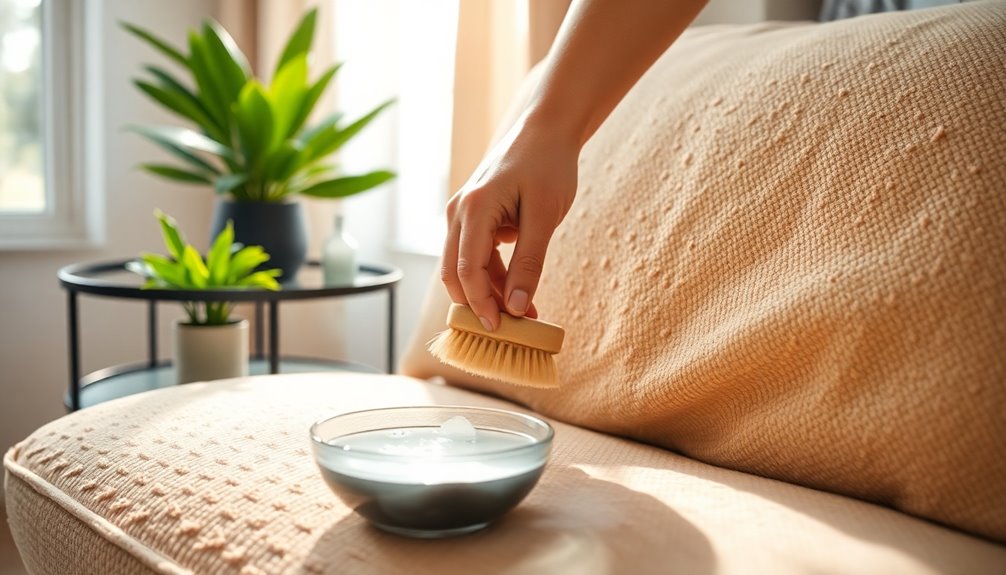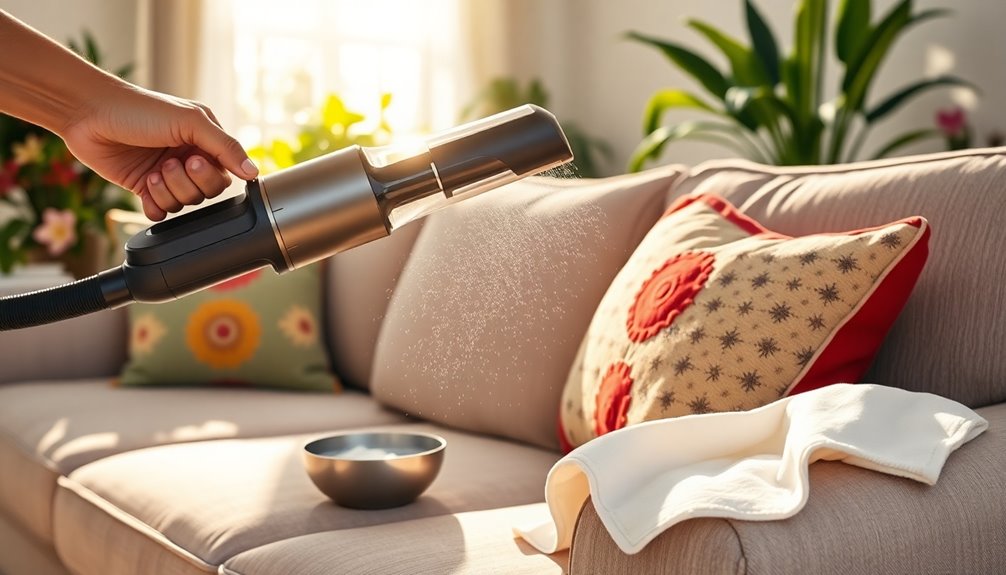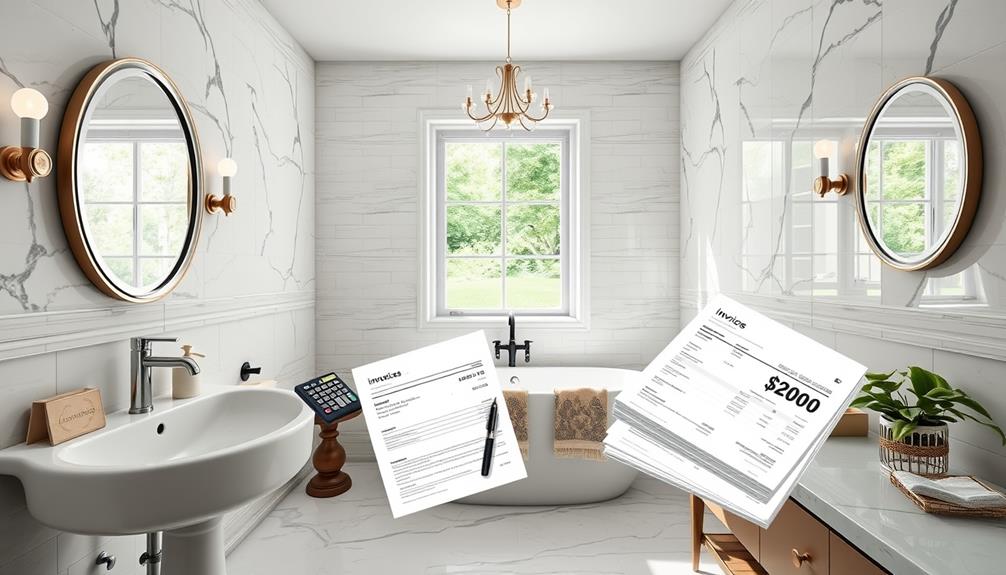To clean your sofa fabric, start by vacuuming it weekly to remove dust and allergens. For spills, quickly blot the area and use a fabric-specific cleaning method: microfiber needs rubbing alcohol, while cloth can be cleaned with a mix of dish soap and vinegar. Always check the manufacturer's cleaning instructions first. Treat stubborn stains with equal parts vinegar and water. Consider applying a fabric protectant annually to keep your sofa looking fresh and prolong its lifespan. By following these steps, you'll maintain your sofa's appearance, and there's more to explore for getting your furniture in top shape.
Key Takeaways
- Regularly vacuum your sofa at least once a week using an upholstery attachment to remove dirt and allergens effectively.
- Spot clean spills immediately to prevent permanent damage, using appropriate cleaners for the specific fabric type.
- Check the manufacturer's cleaning instructions and fabric codes (W, S, WS) to determine the right cleaning method for your sofa.
- For tough stains, consider fabric-safe commercial cleaners and perform spot tests on inconspicuous areas before application.
- Schedule professional cleaning every 12 to 18 months to maintain the sofa's appearance and address any deep cleaning needs.
Introduction
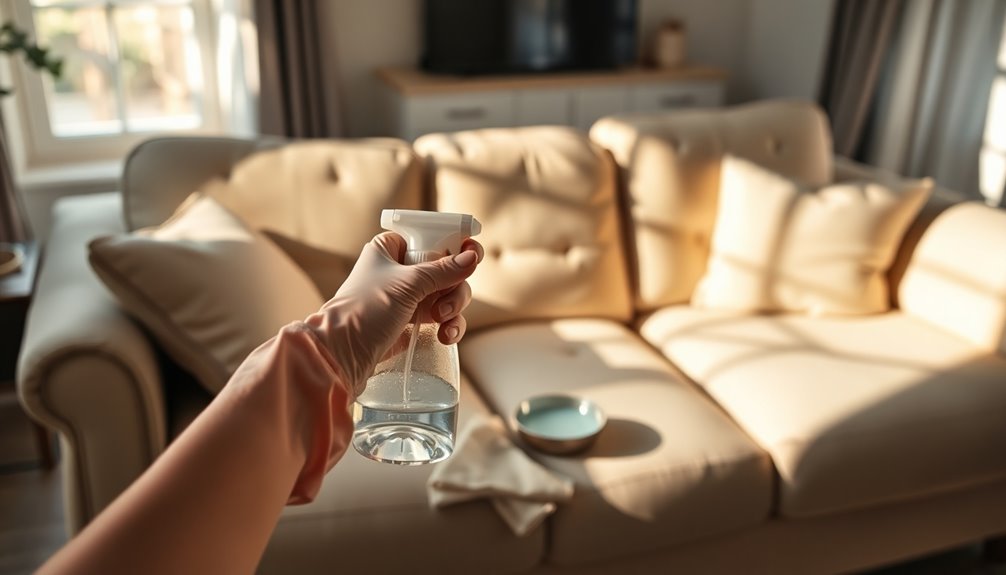
Keeping your sofa fabric clean is essential for both appearance and longevity. You'll want to start with routine vacuuming and spot cleaning, while also using the right techniques based on your fabric type. Plus, knowing how to tackle stubborn stains like wine and coffee can make a big difference in maintaining your sofa's look. Regular vacuuming prevents dirt accumulation, which can help extend the life of your sofa fabric.
Routine Vacuuming and Spot Cleaning
Regularly vacuuming your sofa is essential for maintaining its appearance and prolonging its lifespan. By using an upholstery attachment, you can effectively remove dirt, hair, and allergens, contributing to a cleaner, healthier living environment. It's best to vacuum your sofa at least once a week to prevent debris buildup and keep the fabric looking fresh.
When vacuuming, pay special attention to crevices and under cushions, where dirt and pet hair tend to accumulate. A brush attachment can help you achieve thorough cleaning in these tricky spots.
In addition to routine vacuuming, effective spot cleaning is crucial. If you spill something or notice a stain, act quickly to prevent permanent damage to the fabric. Use a suitable cleaning solution, but don't forget to perform a spot test on an inconspicuous area first. This ensures that the cleaning solution won't harm the fabric. Additionally, using a vacuum with HEPA filters can greatly enhance your cleaning efforts by trapping allergens and improving indoor air quality.
Fabric-Specific Cleaning Techniques
When it comes to cleaning your sofa, understanding the unique requirements of different fabrics is key. Each fabric surface requires specific techniques to avoid damage and maintain appearance. For instance, if your sofa is made of microfiber, you can effectively clean it using rubbing alcohol. Always check the manufacturer's cleaning instructions and fabric care codes before applying any upholstery cleaners.
For cloth couches, a DIY cleaner made from dish soap, vinegar, and warm water works wonders on stains, while baking soda is great for deodorizing. If your sofa is suede, take care to use a damp cloth for refreshing the material, test any cleaning products on a hidden area, and utilize rubber erasers for tough stains like ink or crayon.
Velvet couches require regular vacuuming to maintain their luxurious texture. Address stains promptly with paper towels and a gentle brush to prevent them from setting in. By knowing the right cleaning methods for your specific fabric, you can keep your sofa looking fresh and inviting for years to come.
Tackling Wine and Coffee Stains
Stains from wine and coffee can quickly ruin the appearance of your sofa, but acting fast can make all the difference. For fresh wine stains, immediately blot the area with a clean cloth to absorb excess liquid. Then, sprinkle salt or baking soda over the stain to absorb moisture before vacuuming it away. Coffee stains should also be treated promptly; use a paper towel to blot, then apply a cleaning solution made of one tablespoon of dish soap mixed with two cups of cold water. Dab gently until the stain lifts.
If the stains have set in, try a mixture of equal parts white vinegar and water to break down the stubborn stains before rinsing with a clean damp cloth. Always remember to perform a spot test on an inconspicuous area of the fabric before applying any cleaning solution to ensure it doesn't cause discoloration or damage. If the stain persists, you might need to consider a fabric-safe commercial upholstery cleaner specifically designed for tackling tough wine and coffee stains. With quick action and the right methods, you can restore your sofa's appearance effectively.
Routine Fabric Treatments
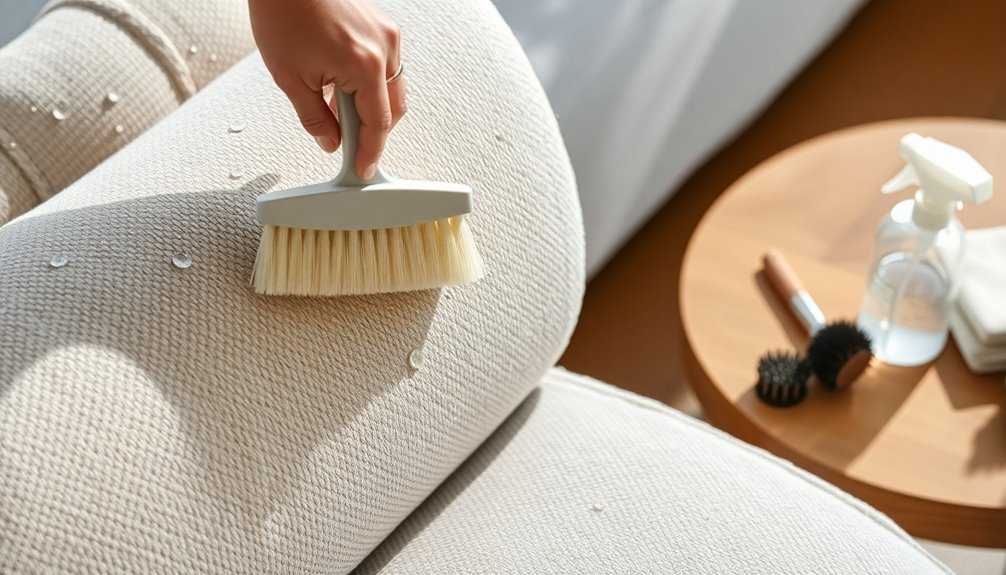
To keep your sofa looking great, consider using durable, stain-resistant fabrics that can withstand everyday wear and tear. Adding patterned throw blankets not only enhances your decor but also protects your sofa from spills and stains. Plus, using furniture coasters under heavy items can prevent indentations and damage to your upholstery.
Using Durable, Stain-Resistant Fabrics
Choosing durable, stain-resistant fabrics for your sofa can make a world of difference in both maintenance and longevity. Fabrics like synthetic microfiber effectively resist spills and stains, reducing the frequency of cleaning. This not only keeps your sofa looking great but also extends its lifespan.
To get the most out of your stain-resistant fabrics, regularly apply fabric protectants such as Scotchgard. These products help repel liquids and prevent stains, but remember, they need periodic reapplication to maintain their effectiveness. Always check the cleaning codes on the manufacturer's label—codes like W, S, or WS—before using any cleaning method. This ensures you don't accidentally damage the material.
Routine maintenance is key. Vacuuming and spot cleaning will keep your sofa looking fresh while preventing dirt and allergens from building up. For tough stains, consider hiring a professional cleaning service that specializes in stain-resistant fabrics. They have the expertise and equipment needed to tackle challenging issues while preserving the integrity of your fabric. Additionally, regular decluttering sessions can help maintain a tidy environment, making it easier to enjoy your clean sofa. By following these steps, you'll keep your sofa in great shape for years to come.
Opt for Patterned Throw Blankets
A patterned throw blanket can be a stylish and practical addition to your sofa, offering protection against spills and stains. By draping a throw over your sofa, you create a barrier that helps keep your fabric clean and fresh. Opt for patterned throw blankets made from washable materials, so you can easily toss them in the laundry when needed. This not only maintains the aesthetic appeal of your living space but also ensures effective fabric protection.
Regularly rotating and washing your throw blankets is essential to prevent odor buildup and maintain a hygienic environment. Plus, layering these blankets can enhance comfort while safeguarding your sofa's underlying fabric. The vibrant patterns can also add a decorative touch, making your sofa a focal point in your room.
Ultimately, incorporating patterned throw blankets into your routine fabric treatments is a simple yet effective way to extend the life of your sofa while keeping it looking its best. With their dual purpose of style and protection, these blankets are a smart choice for any sofa owner.
Using Furniture Coasters Regularly
Your sofa's fabric deserves protection from the weight and movement of heavy furniture, and using furniture coasters regularly can make a significant difference. By distributing the weight of your furniture more evenly, coasters help prevent fabric damage and reduce the risk of unsightly impressions and wear on your upholstery.
Moreover, coasters act as a barrier against moisture and scratches from furniture legs, ultimately extending the lifespan of your sofa's fabric. It's a good idea to check and adjust the coasters periodically, especially after moving furniture, to ensure they remain in the correct position.
Opt for coasters made of non-stick, soft materials to enhance protection against stains and dirt transfer from furniture to your upholstery. By incorporating coasters into your routine maintenance, you'll not only maintain the overall appearance of your sofa but also make it easier to clean. This proactive step can significantly reduce the need for more intensive cleaning methods down the line.
Routine Upholstery Inspections
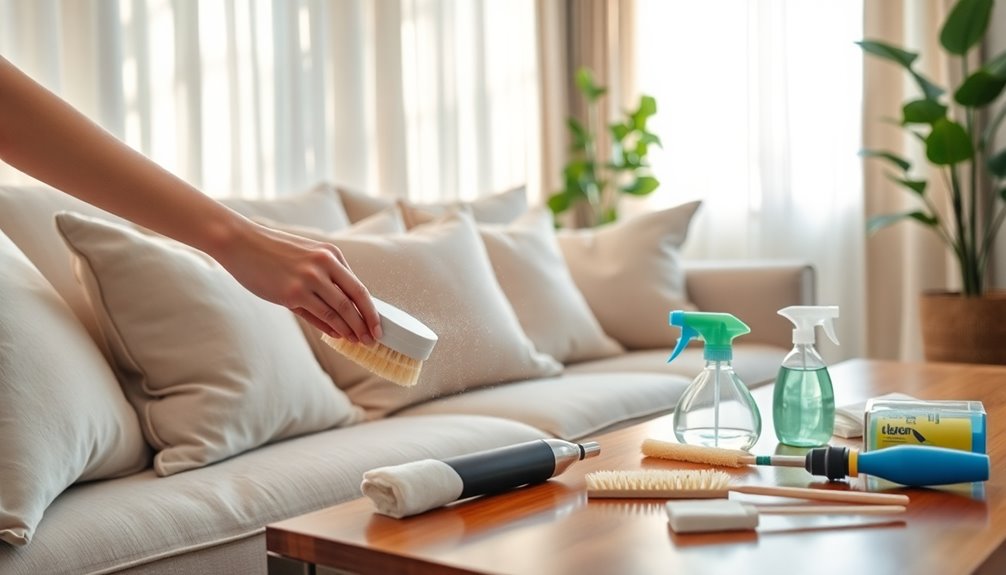
Regular upholstery inspections help you catch frame stability concerns before they escalate. If you notice signs of wear or fading, it might be time to consider reupholstering for a fresh look. Keeping an eye on your sofa's condition can significantly revitalize its appearance and extend its life.
Frame Stability Concerns
Over time, it's essential to inspect your sofa frame for signs of wear that could compromise its stability and comfort. Start by checking for loose joints or cracks, as these can lead to significant issues down the line. If you notice any squeaking or movement when you sit down, it's a clear signal that structural problems may be developing.
Make sure the legs of your sofa are secure and not wobbly; unstable legs can not only affect frame stability but also lead to further damage. Pay attention to the upholstery as well—sagging or uneven wear may indicate that the frame isn't providing adequate support.
Regular upholstery cleaning can help maintain the fabric's appearance, but it's equally vital to keep an eye out for pests. Signs of infestations, like frass or physical damage, can affect both frame and upholstery quality. By routinely inspecting your sofa for these issues, you'll ensure that it remains a comfortable and stable place to relax for years to come. Keeping a proactive approach to frame stability will save you from costly repairs and ensure your furniture stays in top shape.
Reupholstering for a Fresh Look
A vibrant sofa can transform a living space, but over time, even the best fabrics can lose their luster. To keep your sofa looking its best, regularly inspect the upholstery for signs of wear, like fraying seams or discoloration. Make sure to check the cleaning codes on the furniture's tags; this ensures you're using the right cleaning methods and helps prevent fabric damage.
Schedule routine cleaning every 12 to 18 months with an upholstery cleaning machine to maintain the fabric's condition and appearance. If you notice that cleaning no longer restores the original look, it might be time to consider reupholstering. This is especially true for heavily used or stained areas that can detract from your sofa's appeal.
Also, don't overlook the structural integrity of the sofa. Ensure the frame and support systems are intact to avoid further damage to the upholstery. By staying proactive with routine inspections and cleaning, you can significantly extend the life of your sofa and enjoy its fresh look for years to come.
Revitalizing Your Sofa's Appearance
Maintaining the beauty of your sofa requires vigilance and attention to detail. Regularly inspecting your sofa's upholstery is essential for identifying areas needing immediate care. Aim for routine inspections every few months, focusing on seams, cushions, and those high-traffic spots where wear is most visible.
During these checks, pay special attention to any discoloration or stains. Early detection allows you to clean your couch effectively and prevents permanent damage. If you spot any stains, take action right away to remove them before they set in.
Additionally, watch for loose threads or fabric pilling. Addressing these issues promptly helps maintain the fabric's integrity and overall appearance. Document your findings in a cleaning schedule to ensure you stay on top of maintenance. This approach not only keeps your couch looking great but also prolongs the lifespan of its upholstery. Incorporating mindful decluttering strategies can also help you maintain a cleaner and more organized living space, reducing the number of items that may come into contact with your sofa.
Personalized Cushion Designs
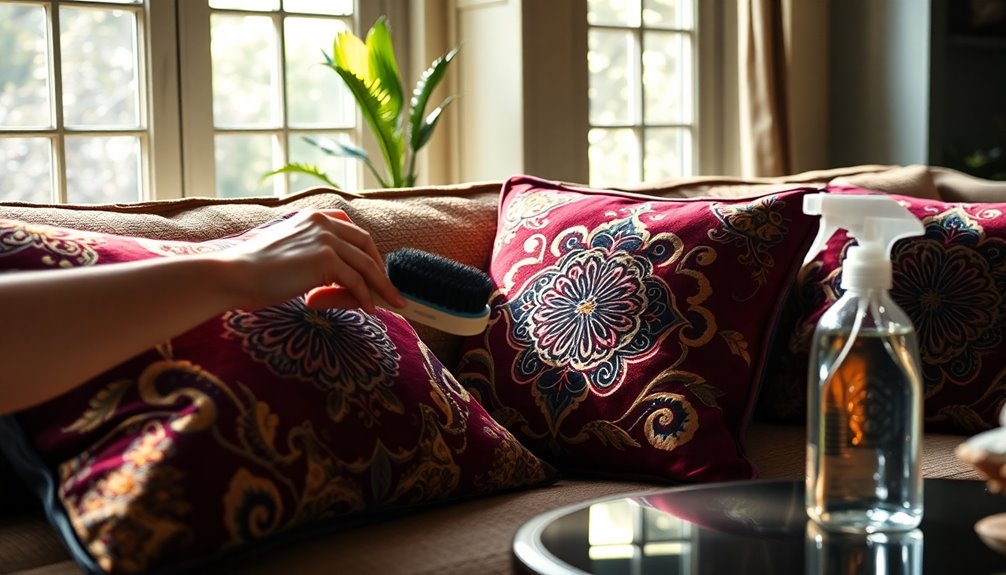
Transforming your sofa with personalized cushion designs not only enhances its aesthetic appeal but also allows you to express your unique style. You can choose custom cushion covers in various fabrics, which make it easy to clean and maintain while ensuring longevity. By selecting different shapes and sizes, you create a dynamic visual effect that also caters to your comfort needs.
Consider removable covers for your cushions; they simplify the cleaning process and allow you to switch styles with the seasons or current trends. This flexibility means you can easily refresh the look of your sofa whenever inspiration strikes.
Incorporating specialty fillings like memory foam into your personalized cushion designs can significantly improve seating comfort, giving you the option to choose your preferred level of firmness or softness. This way, each cushion becomes not just a decorative element but also a personalized comfort zone, tailored specifically to you.
With thoughtful design choices, your sofa can become a true reflection of your taste, combining beauty and practicality with ease of upkeep. Embrace the creativity of personalized cushion designs, and watch your living space transform.
Seasonal Fabric Protection Treatments
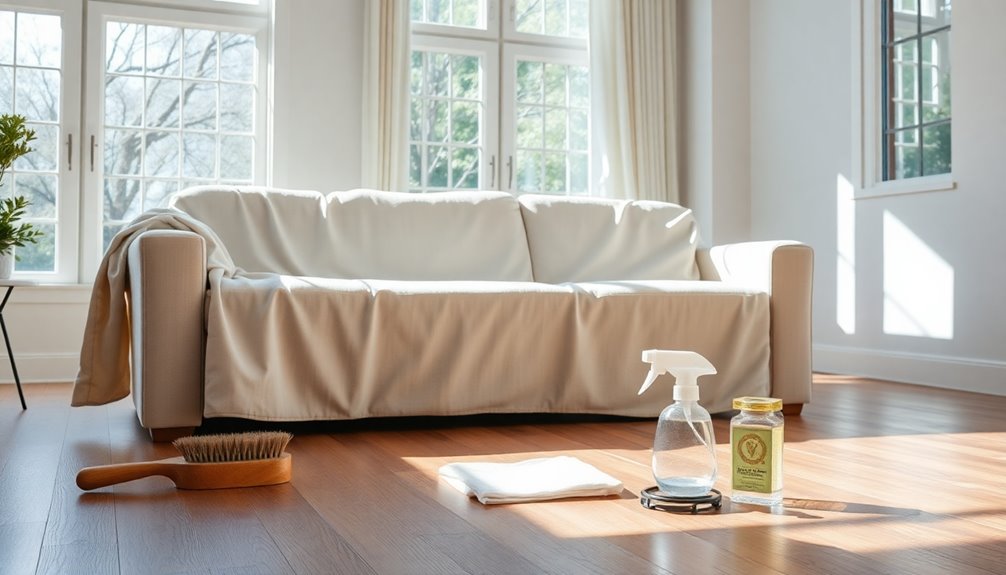
Seasonal fabric protection treatments can be a game-changer for keeping your sofa looking fresh and new. Applying a fabric protectant, like Scotchgard, creates a barrier against spills and stains, helping to maintain the sofa's appearance and prolong its life. It's best to apply these protectants at least once a year or right after deep cleaning, ensuring you don't miss any opportunity to protect your investment.
Before applying the fabric protectant, make sure the fabric is clean and dry. This step allows the protectant to fully penetrate the fibers, providing maximum effectiveness. If you have kids or pets, seasonal treatments are particularly beneficial, as they help prevent long-term damage from accidents and messes.
Always follow the manufacturer's instructions for application and reapplication to ensure the fabric protectant works effectively. Regularly treating your sofa not only keeps it looking good but also makes it easier to clean up spills when they happen. By integrating these seasonal fabric protection treatments into your cleaning routine, you can enjoy a beautiful, well-maintained sofa for years to come.
Conclusion
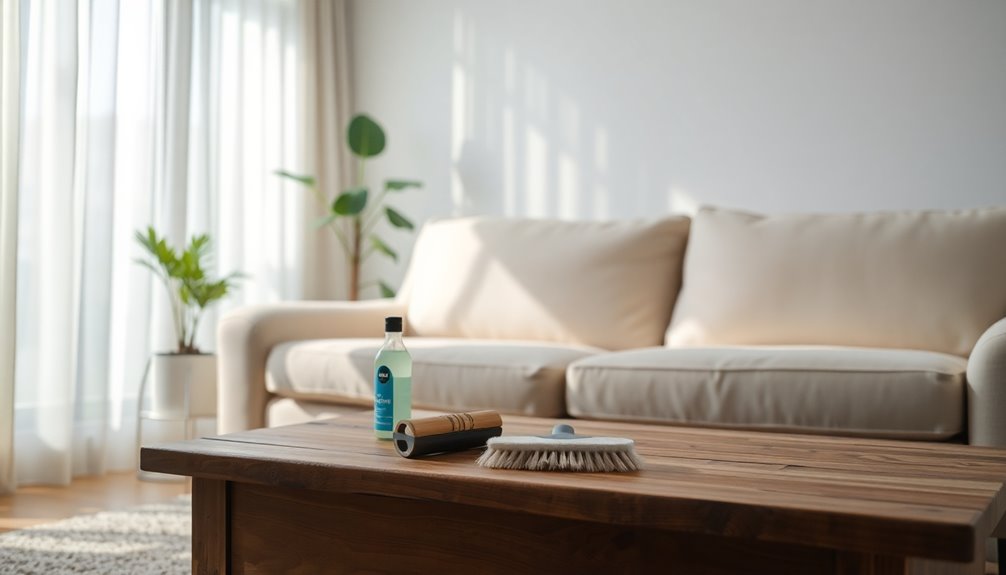
To keep your sofa looking its best, regular cleaning and protection are essential. Ideally, you should clean your sofa fabric once or twice a year to prevent dirt buildup and fabric deterioration. Always check the cleaning codes on your sofa's care label to determine the appropriate cleaning methods. This prevents potential damage and ensures effective care.
Start by vacuuming with an upholstery attachment to remove loose dirt, hair, and allergens. This enhances the effectiveness of your subsequent cleaning efforts. For spot cleaning, consider using a DIY Couch Cleaner made from distilled water, dish soap, and vinegar. Apply this solution gently with a microfiber cloth to tackle stains effectively.
If you encounter tough stains or odors, don't hesitate to reach out to professional cleaning services. They provide deeper cleaning and specialized treatments that can refresh your sofa fabric thoroughly.
Frequently Asked Questions
What Is the Best Way to Clean a Fabric Sofa?
To clean a fabric sofa effectively, you should start by checking the cleaning code on the tag. This tells you which methods are safe. Next, vacuum the sofa thoroughly to get rid of dirt and debris. If the fabric’s water-safe, mix distilled water, dish soap, and vinegar for a DIY solution. Blot any stains gently. For a deeper clean, consider steam cleaning, but always test an inconspicuous area first to ensure compatibility. After addressing any stains, make sure to wipe down the entire sofa with your DIY solution using a soft cloth. If your fabric sofa has removable covers, take them off and follow the washing instructions provided for the best results. For those seeking guidance on how to clean fabric upholstery, remember to consult your manufacturer’s care instructions, as each fabric may require a different approach to maintain its quality.
How to Deep Clean a Sofa at Home?
To deep clean your sofa at home, start by vacuuming it thoroughly to remove loose dirt and debris. Next, mix a solution of distilled water, dish soap, and white vinegar in a spray bottle. Lightly spray the stained areas and blot with a microfiber cloth. If the fabric allows, use a steam cleaner for deeper cleaning. Finally, let your sofa air dry completely, using a fan to speed up the process.
How Do You Clean a Fabric Couch Without Washing It?
To clean a fabric couch without washing it, start by vacuuming thoroughly to eliminate loose dirt and debris. For stains, mix distilled water, dish soap, and vinegar, then dampen a microfiber cloth and gently blot the area. Don't forget to check the fabric's cleaning code for specific instructions. Sprinkle baking soda to absorb odors, letting it sit for 30 minutes before vacuuming. If you have a steam cleaner, test it on a hidden spot first!
How to Clean a Sofa by Hand?
To clean a sofa by hand, start by vacuuming it thoroughly to remove any loose dirt and debris. Check the fabric for cleaning instructions. If it's safe, mix a solution of distilled water, dish soap, and vinegar. Dampen a microfiber cloth with this mixture and gently blot any stains. After that, use a clean cloth dampened with water to rinse the area, then blot dry. Let your sofa air dry completely before using it again.
